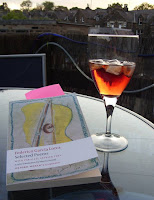Michaelmas

29 th September is the traditional feast of St Michael the Archangel – Michaelmas. Pious legend has it that when Satan was cast down from heaven by St Michael, he landed a bramble thicket. Each year on Michaelmas day, he pisses on all the brambles he can find, leaving their fruit shriveled, sour and unpalatable. (Nothing to do with reduced daylight hours, honest!) Wise foragers will have harvested plenty blackberries well before the end of September, of course. Some of them will get macerated in spirit - the berries, not the foragers! - then sweetened, bottled and put away for the rest of the year. For the less organised among us, the better liquor shops sell crème de mûres sauvages (wild blackberry liqueur). One of my favourites is made by the Cistercian monks who make Chartreuse liqueur, so it pleases me to remember the Michaelmas legend while I’m drinking it. Why am I telling you all this? Surely, liqueurs belong at the end of dinner, to help you relax and see your gues...


